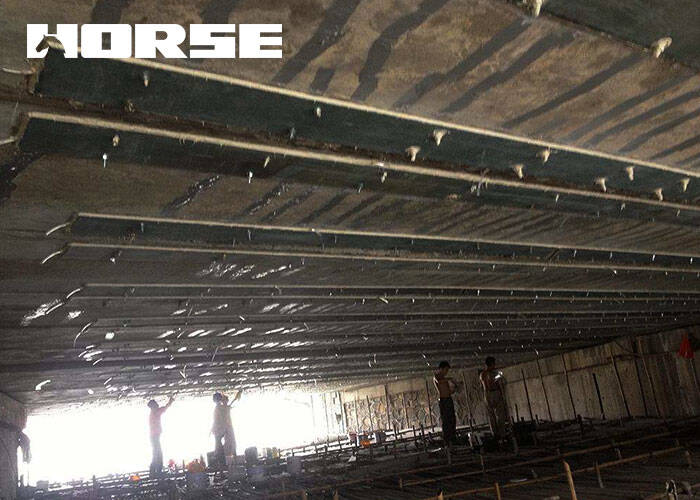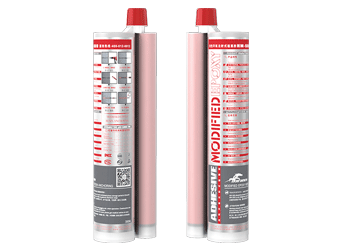Solutions
Horse Construction offers full range of structural strengthening materials with technical supports, documentation supports, products supports, project supports.
bonding steel plate method in bridge strengthening

Bridge maintenance and reinforcement is an important means to extend the service life of bridges. In the maintenance and reinforcement, many different reinforcement methods may be used. Among them, the bonding steel plate method is a simple, effective and most commonly used method, which can exert good construction and economic benefits.
1 Prerequisites and mechanism of use of the pasted steel plate method
1.1 Prerequisites
(1) The actual static and dynamic forces are relatively small.
(2) The actual strength of materials such as concrete reaches 15MPa or more.
(3) The ambient temperature and humidity are within the allowable range of construction, and there is no corrosive medium.
1.2 Mechanism of action
This method usually uses structural glue and epoxy resin to firmly stick the steel plate on the surface of the member to be reinforced, and then fix it with through bolts to ensure that the steel plate and the structure can form a whole. Promote the coordinated force of the component and the steel plate, effectively strengthen and improve the weak parts, enhance the overall shear resistance and bending resistance of the component, and prevent the continuous expansion of cracks on the component
1.3 Basic requirements for materials and construction
(1) The adhesive used in reinforcement should have high strength, durability and flexibility.
(2) The steel plates used in reinforcement are usually 16 manganese steel and No. 3 steel. The weld strength, steel plate and bolt strength should meet the specific requirements of the current technical specifications.
(3) For the bonding strength, not only the actual strength of the bonding agent itself must be ensured, but also the strength of the material. Based on this, the strength of the base material should also be highly valued by relevant personnel.
(4) When reinforcing members in the compression zone, if the steel plate needs to be pasted on the beam side, the width of the steel plate should be controlled within 1/3 of the beam height.
(5) The actual anchorage length outside the reinforcement zone must not only meet the calculation requirements, but also meet the structural requirements, that is, in the tension zone, it should be more than 200 times the thickness of the steel plate and not less than 600mm. In the compression zone, the thickness of the steel plate should be more than 160 times and not less than 480mm. In addition, reliable anchoring measures such as bolts should be provided in the anchoring area.
(6) In order to effectively prevent the steel plate from rusting and slow down the aging speed of the bonding agent, effective waterproof, sealing and anti-corrosion treatments are required on the surface of the steel plate.
2 Sticking steel plate method construction
Before construction, it is necessary to have a detailed understanding of the actual situation of the bridge. In this regard, the bridge structure should be tested and evaluated before the reinforcement construction, and the actual use and bearing capacity of the completed bridge should be comprehensively evaluated. After the assessment, it can be determined whether the bridge structure has the required performance and bearing capacity, and then whether it meets the subsequent traffic requirements, and finally provides decision support for bridge maintenance.
2.1 Process flow
The process of sticking steel plate construction is: erecting brackets→cleaning the surface of the arch ring to remove the rust on the steel plate→washing→drilling holes→gluing→sticking the first layer of steel plate→Set and fix the bolts→Remove the rust on the steel plate and wash it→Apply glue→Paste the steel plate→Set and fix the bolts→Remove the rust on the steel plate and wash it→Painting→Remove the bracket and clean the construction site.
2.2 Process method
2.2.1 Preparation of epoxy mortar
Perform trial matching and process analysis before starting construction, and select appropriate construction cooperation
2.2.2 Surface cleaning of the main arch
This is a very important process and must be taken seriously and taken seriously. However, it is very difficult to clean up, with undulations and weathered layers. In order to ensure the quality of construction, it is necessary to use a polishing machine to polish the surface first to remove the weathered layer. For local damaged parts, high-strength mortar should be used for repair after chiseling.
2.2.3 Remove rust and dirt on the steel plate
Before pasting the steel plate, the surface of the steel plate should be inspected, and the electric steel brush should be used to completely remove the rust. Until the internal metallic luster is exposed, the epoxy mortar should be used for pasting and protection to ensure the quality of the steel plate.
2.2.4 Wash the surface of the main arch and steel plate
After the surface of the main arch and steel plate is polished, rinse with acetone solution to remove all impurities and floating dust.
2.2.5 Drill holes and then set expansion bolts
First, measure and stake out the surface of the main arch to be reinforced, and then use a drill to drill the hole. The hole position should be kept accurate, and the maximum control should be controlled within 2mm to ensure the quality of steel plate installation. The method of operation is: drill holes are set at an interval of 40-50cm on the surface of the member to be reinforced, and at least 6 holes with a diameter of 8mm in 1m2 are required to place bolts. The drilling rig should use an impact hammer as much as possible, and the drilling depth should be strictly controlled according to 3~4cm. After the drilling is completed and the inspection is confirmed, the hole is blown with compressed air, epoxy mortar is injected, and finally bolts are placed in the hole.
2.2.6 Steel plate pasting
The steel plate used on site should be uniformly processed and manufactured in the factory, and the surface should be drilled according to the design requirements. After passing the inspection, it will be transported to the construction site for the next step of rust removal and cleaning, and finally glued and pasted. When the steel plate is pasted, not only must the bolts be used to compress it, but also a support must be set up, which is tightened manually with a hammer until a small amount of glue overflows around. After finishing pasting, tap on the pasting surface to ensure the firmness of pasting.
2.2.7 Concrete pouring construction
The concrete is steel fiber concrete, in which the steel fiber is corrugated steel fiber, its strength can reach 380MPa, and the strength grade is designed according to C40. During the construction process, a grinder should be used to remove the weathered layer and impurities first. After the internal fresh rock layer is exposed, the surface should be washed, and then the concrete should be poured. In the pouring process, a vibrator should be used to vibrate evenly, and finally the surface should be vibrated for continuous curing for at least 7 days.
2.3 Quality inspection
In this project, in order to ensure the quality of steel plate pasting construction, the following two inspection methods were adopted: First, appearance inspection. The inspection content includes: the overflow of glue at the edge (color and hardness). Manually use a small hammer to tap the steel plate and check its bonding area (in the anchoring area, the bonding area should reach more than 90%; in the non-anchoring area, the bonding area should reach more than 70%). After inspection, the construction of this project basically meets the design and specification requirements. Second, sample loading and inspection. It can be seen from this test result that the height of the compression zone has been significantly improved. After the steel plate is pasted, it can realize the coordinated force with the original component and deform together. The rigidity of the components can be improved to a large extent, the main reason is the pouring of steel fiber concrete.
2.4 Anti-corrosion treatment
Manually use an electric brush to remove the rust on the surface of the steel plate, and then repeatedly rinse with acetone solution, brush a layer of rust inhibitor on the bottom, and wait for it to dry, then apply two layers of enamel.
3 Conclusion
(1) Pasting steel plates is a highly technical and demanding method of strengthening bridge structures. It has the advantages of fast progress, no need to use large-scale machinery and equipment, no special requirements for working space, no need to interrupt traffic, and economical and reasonable advantages. It is especially suitable for bridges with large traffic.
(2) This method mainly adopts the pressure-bonding process, which does not produce bubbles and has a good bonding effect. Compared with the traditional glue injection process, it not only saves time and effort, but also is easier to master.
(3) In the actual reinforcement construction, adhesion should be the mainstay, supplemented by necessary anchoring. The adhesion has a very important influence on the early fixation and must be paid attention to by the construction personnel.
(4) When strengthening the bridge, the size of the members to be strengthened is generally very large, so when processing the surface of the material, it is necessary to ensure the flatness and the degree of chiseling on the entire surface needs to be consistent. For example, the corbel at the hanging beam, etc., should be cut with a flat-shaped tool.
(5) The method of pasting the steel plate can reinforce a large area. Usually multiple steel strips are used. When the steel plate is cut, effective measures must be taken to eliminate all defects. If necessary, precision instruments can be used for cutting. In the actual operation process, it should be carried out along the long strip direction to effectively avoid warpage. After the steel strip is pressurized, it should be kept flat to avoid deformation. If the steel strip is not flat, it should be chiseled and trimmed again, paying attention not to use adhesive for leveling.
You can find anything here you are in need of, have a trust trying on these products, you will find the big difference after that.

Two-component epoxy modified epoxy structural strengthening adhesive for bonded steel plate to concrete

Modified epoxy resin structural perfusion adhesive, specifically for supporting adhesive bonded steel reinforcement

Two-components modified epoxy resin adhesive, with high quality plastic tube, double cartridge package for anchoring